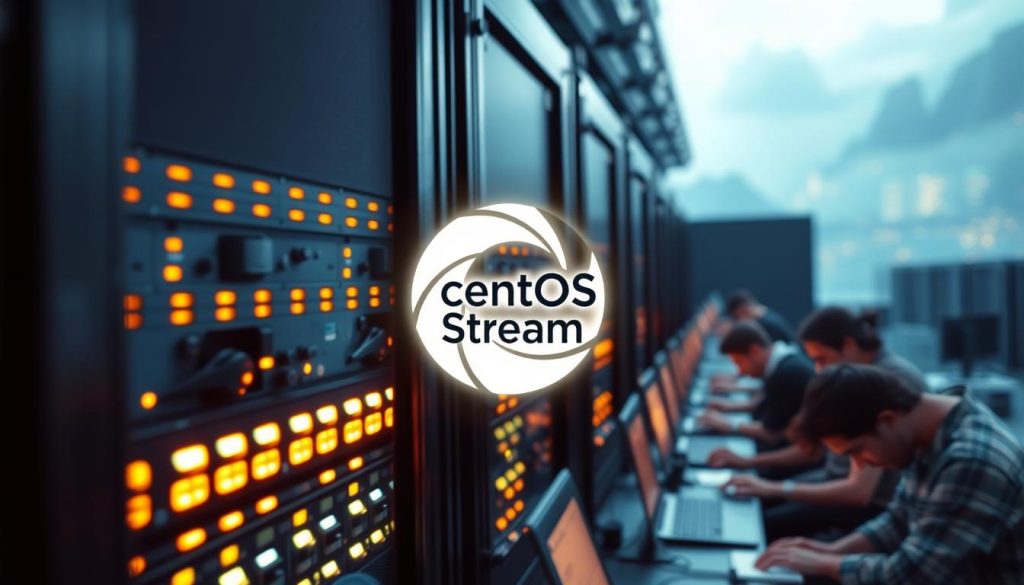Have you ever wondered why major corporations consistently choose specific Linux distribution platforms for their critical infrastructure? We begin by exploring the CentOS Linux platform, an open source project that has transformed enterprise computing. This powerful operating system delivers enterprise-class capabilities derived directly from Red Hat Enterprise Linux source code.
The landscape changed significantly between 2021 and 2024. The CentOS Project discontinued updates for CentOS Linux 8 in December 2021. Support for CentOS Linux 7 concluded on June 30, 2024. Today, CentOS Stream represents the project’s evolution. It serves as the upstream development platform for future Red Hat Enterprise Linux releases. This open source approach ensures continuous innovation.
Our guide demystifies this technology for beginners. We cover the history, key features, and practical applications of this influential Linux distribution. You’ll gain clear understanding of its role in modern enterprise environments.
Key Takeaways
- CentOS originated as a community-driven, free alternative to Red Hat Enterprise Linux
- The platform transitioned significantly between 2021-2024 with version discontinuations
- CentOS Stream now represents the project’s forward-looking development branch
- This operating system maintains enterprise-grade stability and security features
- Understanding CentOS helps businesses make informed infrastructure decisions
- The platform remains relevant for developers and system administrators
- Open source philosophy continues driving the project’s evolution
Introduction to CentOS: History and Evolution
The journey of CentOS began in 2004 as a community-driven initiative. Its full name, the Community Enterprise Operating System, reveals its core mission. The goal was to deliver enterprise-class computing capabilities without the associated licensing fees.
This platform was built to offer the stability and reliability of a commercial-grade Red Hat Enterprise Linux system. It provided a free and accessible alternative for businesses and individual users alike.
Origins and Background
CentOS Linux emerged directly from the source code of Red Hat Enterprise Linux. Developers in the community took this code and rebuilt the distribution. They meticulously removed all proprietary Red Hat branding, logos, and artwork.
This process ensured the underlying functionality and integrity remained perfectly intact. The result was a system that was functionally compatible with its commercial counterpart.
CentOS and Its Connection to Red Hat Enterprise Linux
A pivotal moment occurred in 2014 when Red Hat announced its sponsorship of the CentOS project. This partnership led to the formation of the CentOS Governing Board. This board included Red Hat members who provided guidance and resources.
Despite this closer relationship, the development team maintained its independence in development decisions. The community aspect remained central, with contributors ensuring the distribution stayed accessible to all.
This unique connection solidified the platform’s reputation as a trusted, enterprise-ready Linux distribution. It combined community-driven innovation with the backing of a leading open-source company.
What is CentOS? Understanding Its Role in Linux Distributions
Within the diverse ecosystem of Linux distributions, CentOS Linux occupies a distinctive position that bridges community development with enterprise reliability. This platform represents a complete operating system package combining the Linux kernel with essential tools and applications.
The distribution maintains functional compatibility with Red Hat Enterprise Linux, meaning both platforms share identical core functionality for any given version. Only subscription management tools and proprietary branding differentiate the two systems.
Both platforms utilize the RPM package manager and maintain identical software behavior standards. This technical foundation ensures applications perform consistently across both environments. The commitment to 100% binary compatibility guarantees predictable results.
This unique approach democratizes access to enterprise-grade technology. Organizations can deploy robust computing platforms without licensing barriers. The CentOS project makes enterprise Linux capabilities available to developers, testers, and production environments of all sizes.
The technology community often refers to these platforms collectively as “Enterprise Linux” or “EL.” This terminology reflects their shared codebase and enterprise-focused development philosophy. Both distributions maintain similar security updates and bug fix schedules.
Key Features and Benefits of CentOS
CentOS Linux stands out among operating systems through its unique combination of security and stability features. These characteristics make it particularly valuable for production environments where reliability cannot be compromised.
Enhanced Security with SELinux
The platform integrates Security-Enhanced Linux (SELinux) as a core component. This mandatory access control system operates at the kernel level, enforcing security policies for processes and files.
SELinux provides multiple protection layers beyond standard Linux permissions. Administrators can define granular access control policies that safeguard applications and data from unauthorized access.
Stability Through Extended Support Cycles
Each major CentOS Linux version traditionally receives ten years of support. This includes regular security updates and essential bug fixes throughout the lifecycle.
The longer release cycle ensures mature, thoroughly tested software versions rather than cutting-edge releases. Applications deployed on this platform require fewer updates, reducing maintenance overhead.
Organizations benefit from flexible management options with industry-standard control panels. The technology remains cost-effective as open-source software without licensing fees.
CentOS Linux vs. CentOS Stream: A Comparative Look
The evolution from traditional CentOS Linux to CentOS Stream represents a significant transformation in how enterprise operating systems are developed. These two distributions serve distinct roles within the enterprise Linux ecosystem, each with unique characteristics and purposes.
Differences in Development Approaches
CentOS Linux functioned as a downstream rebuild of Red Hat Enterprise Linux. This meant it was compiled from RHEL source code after official releases. The process involved removing proprietary branding while maintaining complete functionality.
In contrast, CentOS Stream operates as the upstream development platform. It serves as the testing ground for future RHEL releases. This centos stream upstream position allows contributors to participate directly in the development process.
The fundamental differences between these approaches affect stability and innovation cycles. Traditional versions offered predictable, thoroughly tested software. The newer model provides earlier access to upcoming features through continuous integration.
Migration Paths and Update Schedules
Update patterns represent another key distinction between these distributions. CentOS Linux received major version releases with comprehensive updates every few years. Smaller improvements were delivered between these major versions.
CentOS Stream follows a rolling release model with continuous updates. Each revision incorporates upcoming minor RHEL changes. This approach dramatically shortens the development cycle from years to weeks.
The CentOS project decision to discontinue traditional versions requires careful migration planning. Users can transition to CentOS Stream or explore alternative distributions. Understanding these development differences helps organizations choose the right path for their specific needs.
CentOS in Enterprise and VPS Hosting Environments
The adoption of CentOS across enterprise and hosting infrastructures highlights its practical strengths. This enterprise linux platform powered everything from small business websites to high-end corporate applications.
Its reputation for stability and security made it a cornerstone for reliable operations.
Control Panel Options and Management Tools
Effective server management was simplified by a rich ecosystem of control panels. Administrators could choose from industry standards like cPanel, Plesk, and WebMin.
These tools provided graphical interfaces for complex tasks. This broad compatibility stemmed from the platform’s open source roots and its foundation in Red Hat Enterprise Linux.
Hosting providers particularly valued this combination. They could offer clients the robust technology of Red Hat Enterprise Linux without the subscription fees.
Real-World Applications and Community Support
Major organizations demonstrated immense confidence in centos linux. Salesforce, for example, migrated over 200,000 systems, showcasing the platform’s scalability.
Support centos linux primarily flowed from a vibrant, collaborative community. Users helped each other through forums, wikis, and GitHub.
This model provided extensive documentation and collective troubleshooting. For businesses needing guaranteed response times, third-party commercial support was also available.
The growing community continuously improved the distribution. This open source effort ensured the platform evolved to meet user needs, solidifying its role in the enterprise linux landscape.
CentOS and the Broader Enterprise Linux Ecosystem
The enterprise Linux landscape thrives on collaboration between commercial vendors and open source communities. This interconnected environment allows innovations to flow across different distributions while maintaining core compatibility standards.
Collaboration with Red Hat and Industry Partners
Red Hat maintains a unique relationship with the CentOS project through transparent development practices. CentOS Stream serves as the upstream platform where community members and Red Hat engineers collaborate on future enterprise Linux releases.
Special interest groups continue advancing specific technologies within this framework. These SIGs foster innovation in areas like cloud infrastructure and containerization.
Integration with Other Linux Distributions and Open Source Projects
The Red Hat Developer Subscription program bridges community and commercial offerings. This initiative provides free access to Red Hat Enterprise Linux for small-scale deployments.
Following the platform’s evolution, alternatives like Rocky Linux and AlmaLinux emerged. These distributions maintain the downstream rebuild model that characterized earlier versions.
Technical differences between Linux distributions exist at the binary level. However, shared kernel foundations ensure compatibility for popular applications and Docker daemon configuration across platforms.
This interoperability allows organizations to choose distributions matching their specific requirements. The entire ecosystem benefits from shared bug fixes and security enhancements flowing between projects.
Conclusion
Successful technology migrations depend on careful evaluation of organizational needs and platform capabilities. The CentOS Linux platform demonstrated how open source principles could democratize enterprise-grade computing.
This distribution provided remarkable security through SELinux integration and exceptional stability. Extended support cycles and comprehensive control panel options made it invaluable for production environments.
The evolution to CentOS Stream represents a significant shift in development methodology. Organizations now choose between this upstream platform, commercial Red Hat Enterprise Linux, or alternative distributions.
Each option offers distinct approaches to stability, update frequency, and support structures. The broader enterprise linux ecosystem continues thriving with multiple viable paths.
Understanding these platforms helps make informed infrastructure decisions. The foundational benefits of security, flexibility, and transparency remain available across all modern Linux distributions.



